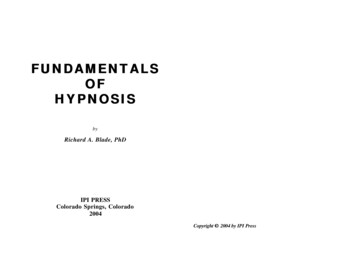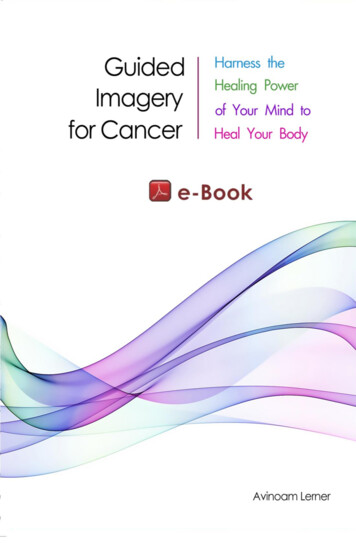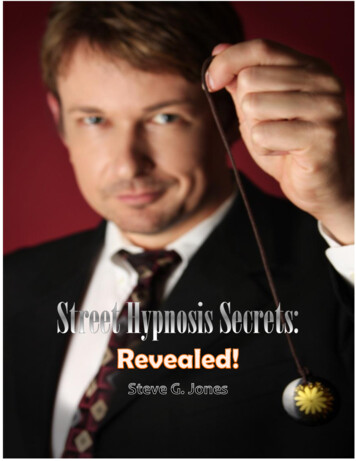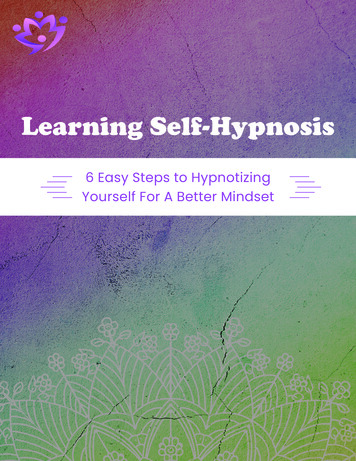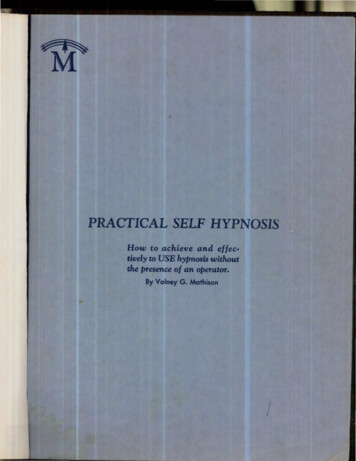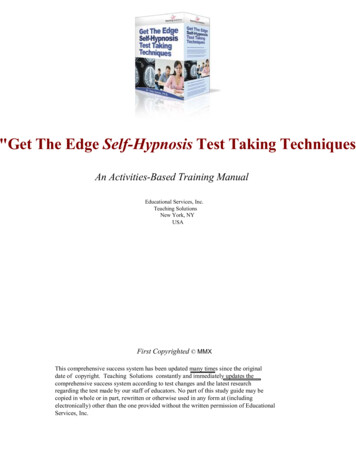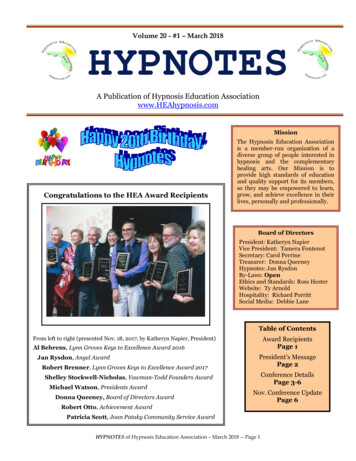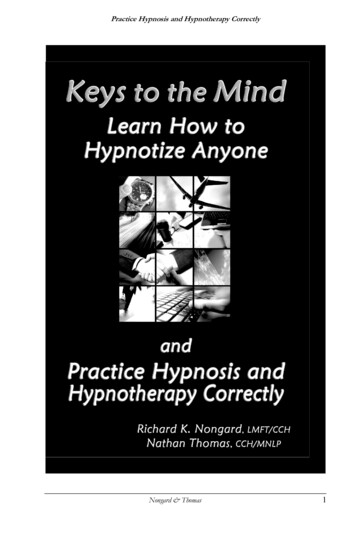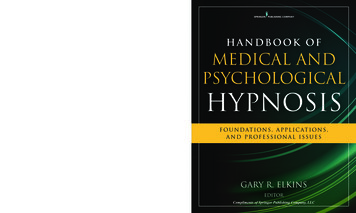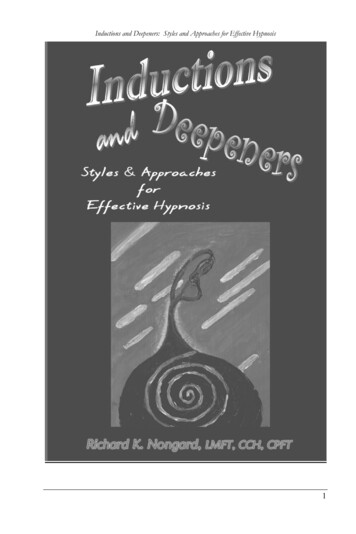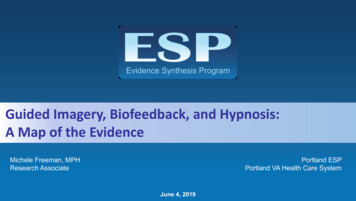
Transcription
Guided Imagery, Biofeedback, and Hypnosis:A Map of the EvidenceMichele Freeman, MPHResearch AssociatePortland ESPPortland VA Health Care SystemJune 4, 2019
AcknowledgmentsThe review team developed the report’s scope, study questions, and methodology in consultation with the Operational Partners(ie, topic nominators), the ESP Coordinating Center, and the technical expert panel (TEP). Broad expertise and perspectiveswere sought. Divergent and conflicting opinions are common and perceived as healthy scientific discourse. Therefore, in the end,study questions, design, methodologic approaches, and/or conclusions do not necessarily represent the views of individualtechnical and content experts.The authors gratefully acknowledge the following individuals for their contributions to this project:Operational PartnersOperational partners are system-level stakeholders who have requested the report to inform decision-making. They recommend TEP members;assure VA relevance; help develop and approve final project scope and timeframe for completion; provide feedback on draft report; and provideconsultation on strategies for report dissemination.Benjamin Kligler, MD, MPHNational DirectorVHA Coordinating Center forIntegrative HealthLaura Krejci, MSWAssociate DirectorVHA Office of Patient Centered Care andCultural Transformation
Acknowledgments, continuedThe authors gratefully acknowledge the following individuals for their contributions to this project:Technical Expert Panel (TEP)To ensure robust, scientifically relevant work, the TEP guides topic refinement; provides input on key questions and eligibility criteria, advising onsubstantive issues or possibly overlooked areas of research; assures VA relevance; and provides feedback on work in progress.Guy Montgomery, PhDJay (Jack) P. Ginsberg, PhDBelleruth Naparstek, ACSWAssociate Professor, Department ofPopulation Health Science and PolicyDirector, Center for Behavioral OncologyIcahn School of Medicine at Mount SinaiClinical Psychologist/Neuropsychologistand Research Health Scientist, DornVAHCSFaculty, Departments of Pharmacology,Physiology & Neuroscience, USC Schoolof MedicinePsychotherapistPresident & CEO, HealthjourneysNationally recognized innovator in the fieldof guided imagery and intuitionDavid Spiegel, MDJeffrey Bolek, PhDDavid Hagedorn, PhD, BCNDirector of the Center on Stress andHealth, and Medical Director of the Centerfor Integrative Medicine at StanfordUniversity School of MedicineDirector, Motor Control Restoration L.L.C.Cleveland Clinic Staff EmeritusCEO, Chief Science Officer, FounderEvoke Neuroscience
DisclosureThis report is based on research conducted by the Evidence Synthesis Program (ESP) Center locatedat the Portland VA Health Care System in Portland, Oregon, funded by the Department of VeteransAffairs, Veterans Health Administration, Health Services Research and Development. The findings andconclusions in this document are those of the author(s) who are responsible for its contents; thefindings and conclusions do not necessarily represent the views of the Department of Veterans Affairsor the United States government. Therefore, no statement in this article should be construed as anofficial position of the Department of Veterans Affairs. No investigators have any affiliations or financialinvolvement (eg, employment, consultancies, honoraria, stock ownership or options, expert testimony,grants or patents received or pending, or royalties) that conflict with material presented in the report.
VA Evidence Synthesis Program overview Established in 2007 Provides tailored, timely, and accurate evidence syntheses of VA-relevant, Veteran-focused healthcare topics. Thesereports help: Develop clinical policies informed by evidence; Implement effective services and support VA clinical practice guidelines and performance measures; and Set the direction for future research to address gaps in clinical knowledge. Four ESP Centers across the US: Directors are VA clinicians, recognized leaders in the field of evidence synthesis, and have close ties to the AHRQ Evidence-basedPractice Center Program and Cochrane Collaboration ESP Coordinating Center in Portland: Manages national program operations and interfaces with stakeholders Produces rapid products to inform more urgent policy and program decisionsTo ensure responsiveness to the needs of decision-makers, the program is governed by a Steering Committee comprised ofhealth system leadership and researchers.The program solicits nominations for review topics several times a year via the program website.
ESP Center locationsCoordinating CenterPortland, ORESP CenterMinneapolis, MNESP CenterPortland, ORHSR&D/QUERI,VACOWashington, DCESP CenterLos Angeles, CAESP CenterDurham, NC
Current reportGuided Imagery, Biofeedback, and Hypnosis:A Map of the EvidencePrincipal Investigator: Michele Freeman, MPHCo-Investigators: Chelsea Ayers, BA, Karli Kondo, PhD, MA, Katherine Noonan, PhD,Maya O’Neil, PhD, Benjamin Morasco, PhD, Devan Kansagara, MD, MCRFebruary 2019Full-length report available on ESP ns/esp/reports.cfm
Input from attendeesPoll questionDo you recommend any of the following interventions inclinical practice? (Select all that apply) Guided Imagery Biofeedback Hypnosis Not applicable to my role/scope of work
Background Guided imagery or guided meditation is a therapeutic technique that uses inwardlyfocused visualization and imaginative content to evoke sensory perceptions forimproving mood and/or physical wellbeing; interventions that rely on externalsensory input (eg, virtual reality or mirror therapy) were excluded. Biofeedback is a method by which a person receives data on physiologicalmeasurements (e.g., heart rate, muscle contractions, and brain wave activity) tohelp regulate physical and mental processes. Hypnosis or hypnotherapy is the induction of a state of consciousness in whichan individual has heightened focus and suggestibility.
Key questions Key question 1 – Guided ImageryIn which populations has guided imagery been examined, and what is theevidence of effectiveness and harms in each of these populations? Key question 2 - BiofeedbackIn which populations has biofeedback been examined, and what is theevidence of effectiveness and harms in each of these populations? Key question 3 – HypnosisIn which populations has hypnosis been examined, and what is theevidence of effectiveness and harms in each of these populations?
Evidence mapsPros Provide a broad (high-altitude) overview of the evidence on an interventionacross diverse health conditions/target populations Can be useful for finding promising areas for treatment and prioritizing furtherresearch Based on methods established for systematic reviews (comprehensiveliterature search, assessment for risk of bias)Cons Based on existing systematic reviews; evidence from recent trials notrepresented Broad brushstrokes about potential benefits; do not characterize magnitudeof treatment effects Cannot be definitive in determining absence of evidence
PICOTS – scope esTimingStudy designIncluded: Adults (18 ) receiving an intervention of interest for any health condition.Excluded: Children and adolescents; healthy/non-elderly volunteers. Guided imagery – forms include guided meditation, yoga nidra, mental practice, mental rehearsal,Katathym-imaginative Psychotherapy, autogenic training, and integrative restoration. Biofeedback – also neurofeedback and neurotherapy. Hypnosis – also hypnotherapy.Excluded: GI/B/H as part of a complex or multicomponent interventionSystematic reviews and meta-analyses comparing an intervention of interest to usual care, placebo, oranother intervention. Primary effects on diagnosis-related symptoms Secondary outcomes, including:- Mental health outcomes (e.g., anxiety and depression) secondary to the diagnosis;- Sleep Global outcomes including quality of life, activities of daily living, mobility, social functioning,employment HarmsAny duration of treatment and follow-up.Included: Systematic reviews and meta-analyses that include randomized or non-randomizedcontrolled trials.Excluded: Non-systematic reviews, reviews of reviews, and primary studies.
Methods – literature searchLiterature search and data sources Search strategy developed by a research librarian and peer reviewed by a 2nd researchlibrarian Multiple databases searched March 2018; search of Ovid/Pubmed updated in September2018 Suggestions from technical experts about potentially relevant reports Reviewed bibliographies for additional studies Search yield dual-reviewed for potentially relevant publications
Methods – inclusion criteriaStudy selection SRs/meta-analyses that included controlled trials of GIBH Study populations defined by medical condition or risk group (e.g., elderly or in ICU)Criteria for potentially eligible SRs1) Provided a reproducible search strategy and inclusion criteria2) Conducted a comprehensive search (at least 2 electronic databases)3) Assessed potential risk of bias of included trialsSelection of SRs for evidence maps For each GIBH intervention we selected a single SR to represent each clinicalcondition/risk group If multiple SRs for a clinical condition: selection based on recentness of searchstrategy, methodological quality, size of the evidence, and applicability
Methods – data collectionData abstraction Characteristics of the intervention, populations studied, clinical condition, number ofstudies, sample size, findings for each outcome (primary, secondary, global health,harms)Risk of bias assessment To qualify for inclusion in our evidence map, SRs had to have assessed themethodological quality of clinical trials using a standardized instrument. We took the primary adjudications conducted by SR authors at face value, and usedtheir ratings in assessing the overall body of evidence.
Methods – effects of the interventionWe classified the evidence of effectiveness into 4 categories:1) No effect: a preponderance of null or negative findings.2) Unclear: Mixed findings for a single outcome with no preponderance of either benefit or negativeeffects, or The number of studies, sample sizes, and/or the methodological quality of the studieswere insufficient to form a conclusion about effectiveness.3) Potential positive effect: Mixed findings for a single outcome that include some evidence of benefit, or Multiple outcomes within the same category (primary diagnosis-related/secondary/global)with at least 1 clear finding of benefit.4) Positive effect: Numerous studies with a preponderance of positive findings, or A large, methodologically sound trial showing a positive effect.
Methods – assessing level of confidenceDomain: range of pointsSample Size: 1 to 3Consistency: -1 or 0Directness: -1 to 0Overall ROB/study quality: -1 or 0Description1: N 1002: N 100-5003: N 500 0 No major flaw,-1 Serious inconsistency0 No major flaw-1 Limited applicability0 Unclear or low ROB-1 High ROB (poor quality)The sum of points from each domain was used to classify level of confidence into 4 categories:(3)(2)High: Consistent findings from larger studies with low risk of bias.Moderate: Larger studies that may have limitations in study quality, applicability, orconsistency of findings.(1) Low: Small sample size, or major deficiencies in the body of evidence.( 0) Insufficient: The body of evidence has unacceptable deficiencies.For the evidence maps, we grouped together Unclear effect with Insufficient confidence.
Results – literature flow2,529 Citations from electronic databases(59.5% from PubMed/Ovid MEDLINE)4 Citations from other sources(reference lists, key experts)2,533 Citations compiled for review of titles and abstracts229 Potentially relevant articles40 included SRs (2 addressed both KQ1 & KQ3)12 SRs ofguided imagery16 SRs ofbiofeedback14 SRs ofhypnosis
Results – N of GIBH trials in targeted health conditions
Results – KQ1: Guided Imagery
Results – KQ1: Guided ImagerySummary of findings 12 SRs examined the effects of guided imagery for anxiety, arthritis, cancer, cardiac surgery, ICUpatients, fibromyalgia, headache, menstrual disorders, musculoskeletal pain, Parkinson’s disease, andstroke. Pre-recorded scripts on audio or video tapes were most commonly used; in-person sessions were alsoused in some studies. Patients with arthritis/rheumatic diseases experienced positive effects on pain symptoms; level ofconfidence in the evidence was moderate. Possible benefits found in several other populations but the findings were mixed and the level ofconfidence in the evidence was low overall.Limitation: variation in what constitutes guided imagery Motor imagery (visualizing/imagining movement without performing the movement physically) wasexcluded in an SR of guided imagery for musculoskeletal pain. Mirror therapy and virtual reality interventions – we excluded because they are externally drivenprocesses/externally derived images; SRs in our search yield included these as guided imagery.
Results – KQ2: Biofeedback evidence map
Results – Biofeedback: summary of findings 16 SRs of biofeedback used alone or as an adjunct to another therapy High-confidence evidence of benefit for primary outcomes: Migraine and tension type headache pain Urinary incontinence after prostatectomy, in adjunct with pelvic floor muscle training. Moderate-confidence evidence of benefit for primary outcomes: Stroke Fecal incontinence Low-confidence evidence of no effect on primary outcomes: Urinary incontinence in women Hypertension
Results – Biofeedback techniques usedConditionBalance/gait trainingBell’s PalsyBiofeedback techniques usedWearable plantar pressure sensors, IMUEMG, biofeedback rehabilitationAdjunctive therapies--With mime therapy. Other therapies varied - facialexpression exercises, lip movement without eye closure.Chronic Idiopathic ConstipationDysphagiaEMG biofeedback, balloon sensory biofeedback, manometry biofeedbacksEMG, accelerometry, tongue manometry, video endoscopy, respiratoryplethysmography, external laryngeal manometryEMG biofeedback, balloon sensory biofeedback,EMG biofeedback, EEG feedback, LENS, SMR trainingTEMP biofeedback, TEMP EMG biofeedback, EMG biofeedback, BVPbiofeedback, EEG biofeedback, GSR biofeedbackBlood pressure biofeedback, indirect biofeedback, direct biofeedback--With swallow therapyFecal ialytic hypotensionKnee osteoarthritis/gait retrainingLabor painRaynaud'sSleep bruxismStrokeUrinary incontinence (women)Urinary incontinence after prostatectomyBiofeedback hemodialysis: BVM with dialysate conductivity control, BVM withplasma conductivity-controlledVisual, haptic (not specified)EMG, skin- conductance biofeedbackThermal biofeedback, thermal feedback EMGContingent electrical stimulationWeight distribution from a force platform or sensor, muscle activity from EMG,linear gait parameters from foot sensors, joint angle from a goniometer.EMG, vaginal and/or anal squeeze pressure, ultrasoundBiofeedback-assisted pelvic floor muscle trainingWith electrical stimulationVaried: PMRVaried - relaxationVaried: relaxation, meditation, imagery, inner qualitymanagement----Varied - relaxation, PMR, Lamaze,Varied - autogenic training, relaxation--With usual therapy including therapist communicationWith pelvic floor muscle trainingVaried - electrical stimulation
Results – KQ2: Hypnosis evidence map
Results – Hypnosis: summary of findings 14 SRs of hypnosis examined a wide range of clinical conditions. Low-confidence evidence that hypnosis is effective for Weight loss in obese adults Anxiety in patients with cancer Symptoms experienced during breast cancer treatment Low-confidence evidence that hypnosis provides no benefit for Smoking cessation Schizophrenia Factors for low confidence: Small samples sizes Poor study quality Inconsistencies across studies within health condition/target population
Limitations to GIBH evidence maps The level of confidence for the majority of outcomes and health conditions was low orinsufficient. Few trials/small combined sample sizes and risk of bias in trials were the mostcommon factors. There is very little information about the impact of GIBH on quality of life and functional status. For biofeedback, we were not able to distinguish the different types of biofeedback modalitiesand evaluate the utility of specific types of biofeedback. The role of blinding The authors of the included SRs often noted lack of patient blinding in trials of GIBH. Blinding is challenging given the nature of these interventions. Expectancy for change may be an integral part of the intervention, in which case blindingwould be counterproductive.
Limitations of evidence map approach Based on existing systematic reviews; did not search for more recently publishedtrials. Not definitive in identifying absence of evidence. Existing evidence from GIBH trialsof targeted health conditions is not represented in the evidence map if no prior SR has reviewed them, or a SR was conducted, but did not meet our minimum quality criteria. We relied on the assessments of study quality made by the authors of the systematicreviews. Our measure for level of confidence in the evidence is approximate; not equivalent tothe more rigorous standards for determining strength of evidence.
Conclusions – GIBH evidence map: benefits and no effects
Conclusions – evidence of no effectPrimary diagnosis-related outcomesEvidence of no effect for:Biofeedback Hypertension Urinary incontinence (women)Secondary outcomes(eg, depression/ anxiety)Global outcomes(eg, quality of life, functional status)Evidence of no effect for:Evidence of no effect for:Biofeedback FibromyalgiaGuided imagery FibromyalgiaGuided imagery ICU patientsHypnosis Schizophrenia Smoking cessationHypnosis Irritable bowelsyndrome Labor/childbirthBiofeedback Fibromyalgia Urinary incontinence (women)Guided imagery FibromyalgiaHypnosis Irritable bowel syndromeThe level of confidence was low for these findings of no effect.
Conclusions – evidence of positive effects Moderate- to high-level confidence that biofeedback is beneficial for Urinary incontinence after prostatectomy Fecal incontinence, Balance and gait in stroke patients Headache Moderate level of confidence that guided imagery has positive effects for arthritis or otherrheumatic diseases. Low-confidence evidence of benefit for hypnosis in patients with Obesity Anxiety in patients with cancer Symptoms during breast cancer treatment
Integrative Health Coordinating Center The IHCC is charged with developing andimplementing CIH strategies in clinical activities,education, and research across the system. Its two major functions are to: identify and remove barriers to providing CIHacross the VHA system. serve as a resource for clinical practices andeducation for both veterans and clinicians.
CIH Policy Directive CIH Directive – SIGNED BY USH blication.asp?pub ID 5401 LIST I: evidence of promising or potential benefit evidence of promising or potential benefit vetted by IHCC Advisory Group VA must provide a mechanism to offer these approaches either within VA facility or in thecommunity LIST II: generally considered safe General recognition of safety requires common knowledge, throughout the expert scientificcommunity (both internal and external to VHA) knowledgeable about the safety of CIHapproaches and the impact on Veterans’ physical and mental well-being, that there is areasonable certainty that the approach is not harmful under the conditions of its intended use. Optional for inclusion in VA facility, depending on capability (staff/space) at sites
CIH Therapies approved to date Acupuncture Tai chi Yoga Meditation Massage therapy Guided imagery Hypnosis BiofeedbackChiropractic included already by specific Congressional mandate
Whole Health ApproachWhole Healthis an approachto health care thatempowers and equipspeople to take chargeof their health and well-being,and live their life to the fullest.
Questions?If you have further questions, please feel free to contact:Devan Kansagara, MD, MCRkansagar@ohsu.eduBen Kligler, MD, MPHBenjamin.Kligler@va.gov Full-length report and cyberseminar available on ESP ns/esp/
Hypnosis or hypnotherapy is the induction of a state of consciousness in which an individual has heightened focus and suggestibility. . Results –Biofeedback techniques used Condition Biofeedback techniques used Adjunctive therapies Balance/gait training---f
